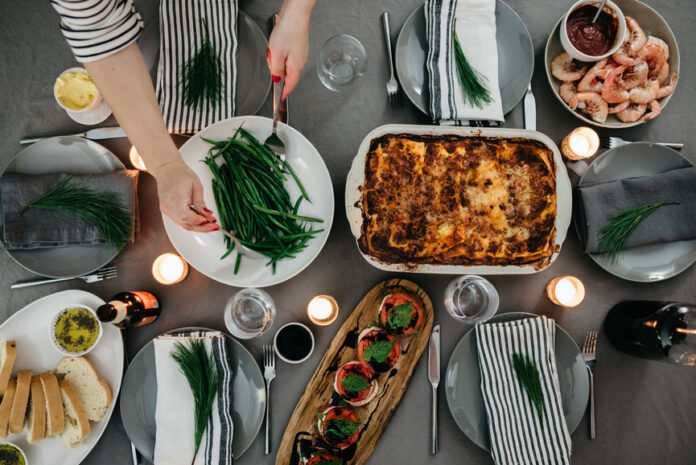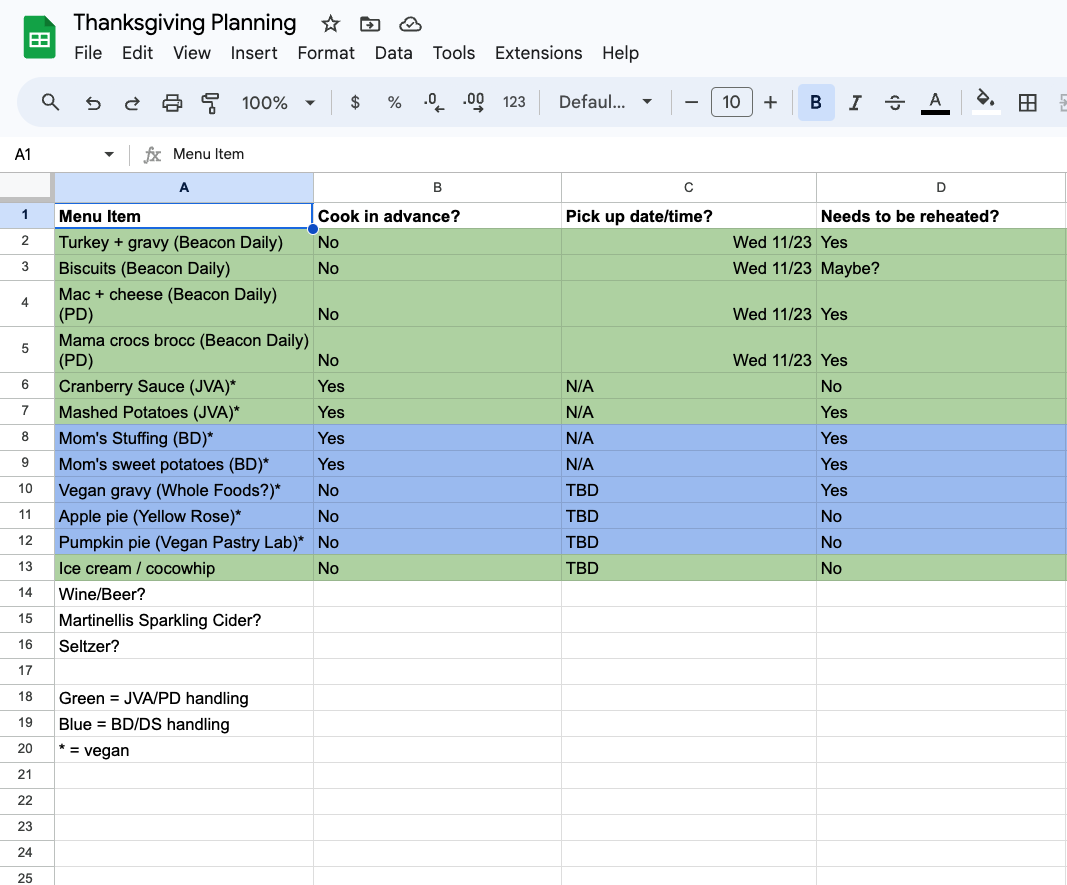Ultimately, I always felt that the food-centric holiday has always felt like an outsized amount of work for what amounts to a fairly mediocre meal.
This isn’t just a Thanksgiving issue, either—most of the winter holidays on the calendar include some kind of elaborate meal (or several), which involves a lot of work and can be incredibly isolating for the people stuck in the kitchen preparing it. Sure, the cooking itself is often a joyful tradition in its own right, but there are also times where the act of making that food can take you away from the very people for whom you’re preparing it. I recall many a Christmas at my grandparents’ house where I wouldn’t even lay eyes on my grandmother until dinner was served at 7 p.m. (And Christmas was usually the only time of year I’d see her.)
The bottom line: Holiday cooking is difficult and stressful, and I’m not the only one who feels this way. According to a 2021 survey of 1,400 people conducted by Cinch Home Services, one in 10 people feel very stressed about Thanksgiving and Christmas, with “timing the cooking just right” the top source of stress for 61 percent of respondents. Another 2021 survey from Irish dairy brand Kerrygold found that 89 percent of respondents were stressed out by the work involved to prepare holiday meals.
So last year when my sister-in-law, who had a young baby, asked my husband and I if we could host Thanksgiving, we thought about how we could make the experience significantly less stressful. The last thing I wanted was to be stuck in the kitchen all day, working my butt off to make food I didn’t care about or enjoy eating, and miss out on time spent with my family. We asked ourselves how we could maximize the best part of the holidays—spending time with loved ones over delicious food.
That’s when we landed on it: a no-cook Thanksgiving.
What a no-cook holiday entails
What that meant: The kitchen was off-limits on Thanksgiving Day, except for reheating. No one was allowed to start or prepare a dish in our kitchen on that day—the oven, stove, and microwave were only meant to get pre-cooked stuff warmed up and ready to eat.
According to a 2021 survey of 1,400 people conducted by Cinch Home Services, one in 10 people feel very stressed about Thanksgiving and Christmas, with “timing the cooking just right” the top source of stress for 61 percent of respondents.
We were worried that people would balk at this idea, but the family was generally pretty supportive. I whipped up a spreadsheet so my sister-in-law and I could figure out what would be on the menu and coordinate what we’d order versus what we’d prep ourselves. We decided that there were four specific dishes we definitely needed at Thanksgiving, all of which could be made vegan so my sister-in-law could eat them too: mashed potatoes, stuffing, cranberry sauce, and sweet potatoes. For everything else—pies, turkey, gravy, and other sides—we opted to order from local restaurants and split the costs.
Once the menu was set, my husband reiterated to his parents that all they needed to do was show up. Meanwhile, I plotted out how reheating would work, Googling “how to reheat X” for literally every item on our menu. The Sunday before Thanksgiving, I cooked the cranberry sauce and stored it in the fridge; the night before, I whipped up the mashed potatoes and transferred them straight into a baking dish for easy reheating the next day.
Finally, the big day arrived. And I was shocked at how much more relaxed everyone was. People were sitting around the living room, laughing and chatting. I was in the kitchen for a total of one and a half hours, mostly just moving things in and out of them oven before coming back into the living room to hang out. We lingered long over dinner, savoring our food, then reconvened in the living room for more chatting while digesting.
The best part: Having a more streamlined menu still allowed for leftovers without requiring a ton of work. (Everyone got to bring home an individual Tupperware filled with their favorites). And having someone else make the turkey and the pies didn’t take away from our enjoyment. In fact, I would argue that the turkey was way better having been made by a professional! And the pies tasted all the sweeter considering that I didn’t have to deal with making the crust.
At the end of the night, as everyone was pulling on their coats and hugging goodbye, my in-laws both said how special the day felt and how much fun they had. And everyone immediately committed to doing Thanksgiving this way every year. [Elle Woods voice] We did it!
How to pull off your own kitchen-less, no-cook holiday meal
Do you also hate the kitchen toil on big holidays and want to try your hand at a cooking-free holiday meal? Here are my tips to set you up for sweet, sweet success:
1. Plan your no-cook holiday menu in advance
Planning ahead is particularly crucial if you’re enlisting the help of other family members to bring or prepare certain dishes. And if you’re ordering from a grocery store or restaurant, I’ve found that holiday orders typically close at least a week in advance.
I usually get things planned about two to three weeks ahead. When thinking about your menu, I approach it by asking a few questions. First, what are must-have items that everyone wants on the table? Prioritize those. For our Thanksgiving, we leave room for having a few cherished family recipes (like my mother-in-law’s stuffing and my brother’s cranberry sauce). It’s also a good idea to think about what likely reheats well. Crispy Brussels sprouts, while delicious, won’t be quite as amazing texture-wise when reheated, so maybe try a different vegetable side instead.
Don’t forget to factor in family members’ allergies, dietary constraints, or health conditions when planning the menu, too. Ask for that information before you start to plan; don’t expect people to remember to share that. Ideally, there should be at least one or two dishes that everyone can eat. If someone has a highly restrictive diet that’s challenging to accommodate, it’s worth having a separate conversation with them to get specific ideas on what kinds of things they’d like and encourage them to bring something to share.
Once that’s all thought out, I make a spreadsheet that lists out each dish we want, and has columns for who is bringing the dish, when it needs to be picked up if it’s an outsourced item, and whether it needs to be reheated the day of the gathering. Sharing that with other people who are involved in the event planning is an easy way to gain consensus on the menu, and you can assign items to people or ask people mark down directly in the spreadsheet what they want to bring.
2. Outsource stuff you don’t want to cook or don’t have time to cook
Often, holiday meals include food items that are typically only prepared and eaten once a year. Why contribute to the stress of the season by taking on a complicated dish that requires chef-level training, especially if you don’t have the time or inclination to do so?
For my sanity, I leave certain dishes—like Thanksgiving turkey or holiday pies—to the pros. Lots of local restaurants offer catering options that allow you to pick up a day or so before the holiday, and in my experience, they’re as good if not better than homemade fare. They also typically include reheating instructions, which makes doing the next tip a little bit easier.
3. Think about your reheating timeline
Once you have all of your menu items—and have identified what needs reheating vs. what can be served cold or room temperature—it’s time to plot out your reheating strategy. For Thanksgiving, I gave myself an hour and a half to get everything reheated, so I planned to start preheating my oven at around 12:45 p.m. in order to have stuff served by 2:30 p.m.
The specifics depend on what dishes you have and how many you have to reheat; in general, expect to reheat each dish at 350° F for at least 10-30 minutes each. (I find that meat, especially if it’s a whole roast or whole bird, will take the longest to reheat, so put that in first.) Plan to use all of the shelves in your oven to maximize how many things you can reheat at once. And don’t forget to make use of all possible appliances if you have a lot of dishes to reheat. I had things simultaneously cooking in my regular oven, my countertop convection oven, and microwave; you could also use an airfryer or an Instant Pot to heat things or keep them warm.
In general, expect to reheat each dish at 350° F for at least 10-30 minutes each. (I find that meat, especially if it’s a whole roast or whole bird, will take the longest to reheat, so put that in first.)
Inevitably, you’ll have some things that have properly warmed up before others, or you’ll need to reheat in batches if you have bigger dishes or a small oven. No problem! Try this hack I learned from the hosting queen Brunch with Babs on TikTok: Take a large, hard-sided cooler (borrow one from a friend or family member if you don’t have one), and pour hot, steaming (but not boiling) water inside. Ideally you’d want enough to fill up two inches of the cooler. Close the lid to trap in the heat and let the cooler heat up, then drain the water. You now have a Thermos-style container to keep cooked dishes nice and toasty before serving!
My last tip on this front: You will need multiple timers to keep track of how long various dishes are cooking. I recommend using your phone (or Alexa or other smart device) and giving each timer a name. In my case, I would ask Siri to set a mashed potato timer for 15 minutes, and a turkey timer for 30 minutes. That way you have a better sense of what has been in for how long, or what ringing timer is for which dish.
4. Stick with your boundaries, even if it’s awkward
The hardest thing about having a reheating holiday is sticking with the boundary. Holiday foods and traditions are very charged emotionally, and people might feel hurt or offended that you want to do things a certain way. But if you’re hosting, it’s your rules—so stay polite but firm when people want to bring something that requires tons of day-of prep, or balk at the idea of outsourcing certain items.
Instead, give people opportunities to contribute within that framework. If people are used to helping in the kitchen, for example, ask them to instead help out with dishes, or setting the table, or setting various reheating timers. If your mother-in-law or grandma is really set on having a family dish on the menu, ask her to bring it. And if cooking is a key part of the tradition, set up a more chill cooking party in advance where there’s less stress—and bring the results of what you made to the actual holiday dinner.
5. Enjoy the moment!
The whole point of this is so that you don’t spend all day in the kitchen. Savor that and don’t forget to spend time with your loved ones who are gathered. Bust out a game! Take silly pictures! Ask your grandma to share stories about her childhood! And of course, don’t forget to keep the wine (or non-alc festive bev of your choice) flowing.



